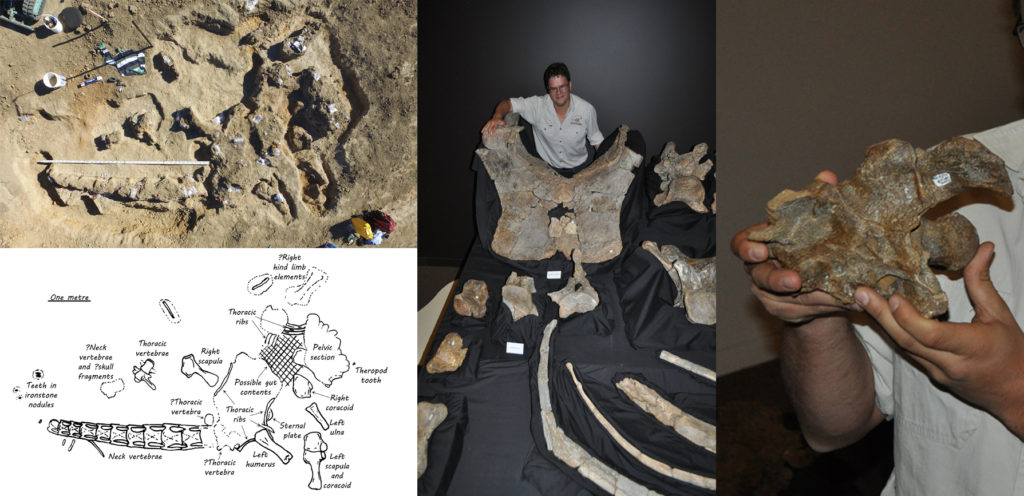Our Mesozoic Menagerie: Australia’s Dinosaurs

Dr Stephen Poropat
Research Associate, The Australian Age of Dinosaurs Museum of Natural History
Postdoctoral Researcher, Swinburne University of Technology
Four major sites are currently providing new insights into Australia’s Cretaceous dinosaurs, who lived from 145 to 66 million years ago. These are the Broome trackways in Western Australia, the Strzelecki and Otway ranges in Victoria, Lightning Ridge in New South Wales, and the Eromanga Basin in Queensland. Swinburne University palaeontologist Dr Stephen Poropat has been digging up Australian dinosaur fossils since 2004, and will share his latest exciting findings!
To date, only twenty Australian dinosaurs from the Mesozoic Era have been formally named on the basis of fossilised bones, and almost all of these are from the middle part of the Cretaceous, between 125 and 95 million years ago. This means that we have little idea of what Australia’s Mesozoic dinosaurs were like throughout much of their existence.
Victoria’s Cretaceous dinosaur faunas were dominated by ornithopod dinosaurs. These small plant-eaters have left abundant evidence of their existence in the form of limb bones, vertebrae, teeth and skull fragments, as well as four partial skeletons and even footprints and possible burrows. They coexisted with a variety of different theropod dinosaurs—some of which had teeth adapted for rending flesh—as well as very rare armoured ankylosaurs and even rarer possible ceratopsians. Our understanding of this dinosaur faunas has improved massively as a result of the efforts of hundreds of volunteers over the past forty years—without their efforts, our knowledge would be very limited indeed. Dr Stephen Poropat has had the privilege of attending six such digs since 2004.
Long-necked, plant-eating sauropods are completely unknown from the Victorian Cretaceous. Their absence has been attributed to their presumed inability to deal with cool climates. In contrast, the Cretaceous rocks of the Eromanga Basin in Queensland produce sauropods in abundance. Although the earliest such discoveries were made in the 1920s and 1930s, it was David Elliott’s 1999 discovery of a dinosaur on his sheep station which reinvigorated excavation efforts in the Eromanga Basin. Annual digs in the Winton area, coordinated by the Australian Age of Dinosaurs Museum of Natural History (AAOD, founded by David and his wife Judy), have been held since 2001. Stephen has helped supervise eight such AAOD digs since 2011, and this year’s excavations were some of the most successful to date – come learn more!
ABOUT THE SPEAKER:
Born and raised in Melbourne, Australia, Dr Stephen Poropat wanted to be a palaeontologist from the moment he could pronounce the word. He studied science at Monash University from 2003 to 2006 with the aim of pursuing a career in palaeontology, and in 2011 he completed his Ph.D. on ostracod biostratigraphy and palaeoenvironmental reconstruction.
Stephen has worked as a Research Associate with the Australian Age of Dinosaurs Museum of Natural History in Winton, Queensland since 2011. He combined this work with a placement as a Postdoctoral Research Fellow with Uppsala University in Sweden. In 2017 Stephen moved from Uppsala back to Melbourne, to take up a position as a Postdoctoral Researcher with the Swinburne University of Technology.






